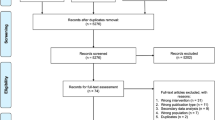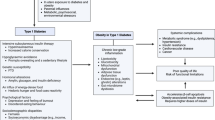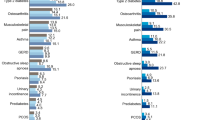Abstract
There is a growing burden of cardiometabolic disease in many parts of the world. Despite some progress in its prevention, more can be done to tackle risks of its development in the community and in different specialty clinics. Currently, the identification and management of those at elevated risk of developing cardiovascular disease or diabetes or with conditions such as fatty liver disease remains fragmented and is not linked to constructive lifestyle advice. In this Perspective, we argue for a more consistent weight-management approach, alongside a holistic assessment of the risk for developing cardiometabolic diseases, offering patients a range of simple or more-intensive evidence-based lifestyle options in an empathetic manner, with encouragement for repeated attempts and a willingness to embrace failure.
This is a preview of subscription content, access via your institution
Access options
Access Nature and 54 other Nature Portfolio journals
Get Nature+, our best-value online-access subscription
$29.99 / 30 days
cancel any time
Subscribe to this journal
Receive 12 print issues and online access
$209.00 per year
only $17.42 per issue
Buy this article
- Purchase on Springer Link
- Instant access to full article PDF
Prices may be subject to local taxes which are calculated during checkout


Similar content being viewed by others
References
Sun, X. & Du, T. Trends in cardiovascular risk factors among U.S. men and women with and without diabetes, 1988-2014. BMC Public Health 17, 893 (2017).
Dagenais, G.R. et al. Variations in common diseases, hospital admissions, and deaths in middle-aged adults in 21 countries from five continents (PURE): a prospective cohort study. Lancet https://doi.org/10.1016/S0140-6736(19)32007-0 (2019).
Blüher, M. Obesity: global epidemiology and pathogenesis. Nat. Rev. Endocrinol. 15, 288–298 (2019).
Danaei, G. et al. National, regional, and global trends in fasting plasma glucose and diabetes prevalence since 1980: systematic analysis of health examination surveys and epidemiological studies with 370 country-years and 2·7 million participants. Lancet 378, 31–40 (2011).
Piepoli, M. F. et al. 2016 European Guidelines on cardiovascular disease prevention in clinical practice: The Sixth Joint Task Force of the European Society of Cardiology and Other Societies on Cardiovascular Disease Prevention in Clinical Practice (constituted by representatives of 10 societies and by invited experts) Developed with the special contribution of the European Association for Cardiovascular Prevention & Rehabilitation (EACPR). Eur. Heart J. 37, 2315–2381 (2016).
Larsson, S. C., Bäck, M., Rees, J. M. B., Mason, A. M. & Burgess, S. Body mass index and body composition in relation to 14 cardiovascular conditions in UK Biobank: a Mendelian randomization study. Eur. Heart J. 41, 221–226 (2020).
Gregg, E. W., Sattar, N. & Ali, M. K. The changing face of diabetes complications. Lancet Diabetes Endocrinol. 4, 537–547 (2016).
Steinarsson, A. O. et al. Short-term progression of cardiometabolic risk factors in relation to age at type 2 diabetes diagnosis: a longitudinal observational study of 100,606 individuals from the Swedish National Diabetes Register. Diabetologia 61, 599–606 (2018).
Donnelly, L. A. et al. Rates of glycaemic deterioration in a real-world population with type 2 diabetes. Diabetologia 61, 607–615 (2018).
Hussain, S. & Chowdhury, T. A. The impact of comorbidities on the pharmacological management of type 2 diabetes mellitus. Drugs 79, 231–242 (2019).
Zelniker, T. A. et al. SGLT2 inhibitors for primary and secondary prevention of cardiovascular and renal outcomes in type 2 diabetes: a systematic review and meta-analysis of cardiovascular outcome trials. Lancet 393, 31–39 (2019).
Kristensen, S. L. et al. Cardiovascular, mortality, and kidney outcomes with GLP-1 receptor agonists in patients with type 2 diabetes: a systematic review and meta-analysis of cardiovascular outcome trials. Lancet Diabetes Endocrinol. 7, 776–785 (2019).
Valabhji, J. et al. Early outcomes from the English National Health Service Diabetes Prevention Programme. Diabetes Care 43, 152–160 (2020).
Welsh, C. et al. Glycated hemoglobin, prediabetes, and the links to cardiovascular disease: data from UK Biobank. Diabetes Care 43, 440–445 (2020).
Preiss, D., Khunti, K. & Sattar, N. Combined cardiovascular and diabetes risk assessment in primary care. Diabet. Med. 28, 19–22 (2011).
Sattar, N. et al. Can metabolic syndrome usefully predict cardiovascular disease and diabetes? Outcome data from two prospective studies. Lancet 371, 1927–1935 (2008).
Osorio, M. et al. Community-based hemoglobin A1C testing in barbershops to identify black men with undiagnosed diabetes. JAMA Intern. Med. https://doi.org/10.1001/jamainternmed.2019.6867 (2020).
Chang, K. C.-M. et al. Coverage of a national cardiovascular risk assessment and management programme (NHS Health Check): Retrospective database study. Prev. Med. 78, 1–8 (2015).
Jørgensen, T. et al. Effect of screening and lifestyle counselling on incidence of ischaemic heart disease in general population: Inter99 randomised trial. Br. Med. J. 348, g3617 (2014).
Mihaylova, B. et al. The effects of lowering LDL cholesterol with statin therapy in people at low risk of vascular disease: meta-analysis of individual data from 27 randomised trials. Lancet 380, 581–590 (2012).
Williams, B. et al. 2018 ESC/ESH Guidelines for the management of arterial hypertension. Eur. Heart J. 39, 3021–3104 (2018).
Hippisley-Cox, J., Coupland, C. & Brindle, P. Development and validation of QRISK3 risk prediction algorithms to estimate future risk of cardiovascular disease: prospective cohort study. Br. Med. J. 357, j2099 (2017).
Chang, L.-S., Vaduganathan, M., Plutzky, J. & Aroda, V. R. Bridging the gap for patients with diabetes and cardiovascular disease through cardiometabolic collaboration. Curr. Diab. Rep. 19, 157 (2019).
Nicholson, B. D. et al. Determinants and extent of weight recording in UK primary care: an analysis of 5 million adults’ electronic health records from 2000 to 2017. BMC Med. 17, 222 (2019).
Barnard, N. D. Ignorance of nutrition is no longer defensible. JAMA Intern. Med. 179, 1021 (2019).
Lim, E. L. et al. Reversal of type 2 diabetes: normalisation of beta cell function in association with decreased pancreas and liver triacylglycerol. Diabetologia 54, 2506–2514 (2011).
Gong, Q. et al. Morbidity and mortality after lifestyle intervention for people with impaired glucose tolerance: 30-year results of the Da Qing Diabetes Prevention Outcome Study. Lancet Diabetes Endocrinol. 7, 452–461 (2019).
Aveyard, P. et al. Screening and brief intervention for obesity in primary care: a parallel, two-arm, randomised trial. Lancet 388, 2492–2500 (2016).
Kliemann, N., Croker, H., Johnson, F. & Beeken, R. J. Development of the top tips habit-based weight loss app and preliminary indications of its usage, effectiveness, and acceptability: mixed-methods pilot study. JMIR Mhealth Uhealth 7, e12326 (2019).
Jebb, S. A. et al. Primary care referral to a commercial provider for weight loss treatment versus standard care: a randomised controlled trial. Lancet 378, 1485–1492 (2011).
Lean, M. E. J. et al. Durability of a primary care-led weight-management intervention for remission of type 2 diabetes: 2-year results of the DiRECT open-label, cluster-randomised trial. Lancet Diabetes Endocrinol. 7, 344–355 (2019).
Astbury, N. M. et al. Doctor Referral of Overweight People to Low Energy total diet replacement Treatment (DROPLET): pragmatic randomised controlled trial. Br. Med. J. 362, k3760 (2018).
Ahern, A. L. et al. Extended and standard duration weight-loss programme referrals for adults in primary care (WRAP): a randomised controlled trial. Lancet 389, 2214–2225 (2017).
Jensen, P. et al. Long-term effects of weight reduction on the severity of psoriasis in a cohort derived from a randomized trial: a prospective observational follow-up study. Am. J. Clin. Nutr. 104, 259–265 (2016).
Can weight loss help patients with atrial fibrillation? (LOSE-AF) Clinicaltrials.gov https://clinicaltrials.gov/ct2/show/NCT03713775 (accessed 23 September 2019).
Piercy, K. L. et al. The physical activity guidelines for americans. J. Am. Med. Assoc. 320, 2020–2028 (2018).
Celis-Morales, C. A. et al. Association between active commuting and incident cardiovascular disease, cancer, and mortality: prospective cohort study. Br. Med. J. 357, j1456 (2017).
Murphy, M. H., Lahart, I., Carlin, A. & Murtagh, E. The effects of continuous compared to accumulated exercise on health: a meta-analytic review. Sports Med. 49, 1585–1607 (2019).
Harris, T. et al. Effect of a primary care walking intervention with and without nurse support on physical activity levels in 45- to 75-year-olds: the Pedometer And Consultation Evaluation (PACE-UP) cluster randomised clinical trial. PLoS Med. 14, e1002210 (2017).
Feter, N., Dos Santos, T. S., Caputo, E. L. & da Silva, M. C. What is the role of smartphones on physical activity promotion? A systematic review and meta-analysis. Int. J. Public Health 64, 679–690 (2019).
Ekelund, U. et al. Dose-response associations between accelerometry measured physical activity and sedentary time and all cause mortality: systematic review and harmonised meta-analysis. Br. Med. J. 366, l4570 (2019).
Wyke, S. et al. The effect of a programme to improve men’s sedentary time and physical activity: The European Fans in Training (EuroFIT) randomised controlled trial. PLoS Med. 16, e1002736 (2019).
Leong, D. P. et al. Prognostic value of grip strength: findings from the Prospective Urban Rural Epidemiology (PURE) study. Lancet 386, 266–273 (2015).
Celis-Morales, C. A. et al. Associations of grip strength with cardiovascular, respiratory, and cancer outcomes and all cause mortality: prospective cohort study of half a million UK Biobank participants. Br. Med. J. 361, k1651 (2018).
Kamada, M., Shiroma, E. J., Buring, J. E., Miyachi, M. & Lee, I.-M. Strength training and all-cause, cardiovascular disease, and cancer mortality in older women: a cohort study. J. Am. Heart Assoc. 6, e007677 (2017).
Stamatakis, E. et al. Does strength-promoting exercise confer unique health benefits? A pooled analysis of data on 11 population cohorts with all-cause, cancer, and cardiovascular mortality endpoints. Am. J. Epidemiol. 187, 1102–1112 (2018).
Physical activity guidelines: UK Chief Medical Officers’ report. https://www.gov.uk/government/publications/physical-activity-guidelines-uk-chief-medical-officers-report (accessed 24 September 2019).
Ueda, P. et al. Laboratory-based and office-based risk scores and charts to predict 10-year risk of cardiovascular disease in 182 countries: a pooled analysis of prospective cohorts and health surveys. Lancet Diabetes Endocrinol. 5, 196–213 (2017).
Acknowledgements
N.S. receives funding from the British Heart Foundation Research Excellence Award (RE/18/6/34217). We thank L. Coyle for technical support.
Author information
Authors and Affiliations
Corresponding author
Ethics declarations
Competing interests
N.S. has consulted for Amgen, AstraZeneca, Boehringer Ingelheim, Eli Lilly, Novo Nordisk, Pfizer and Sanofi, and received grant support from Boehringer Ingeheim outside the submitted work. J.S. has received speakers’ honoraria from Janssen WA reports consultancy and sponsored lectures from Gilead, GlaxoSmithKline, Intercept IQVIA and UCB Pharma.
Additional information
Peer review information Hannah Stower was the primary editor on this article, and managed its editorial process and peer review in collaboration with the rest of the editorial team.
Publisher’s note Springer Nature remains neutral with regard to jurisdictional claims in published maps and institutional affiliations.
Rights and permissions
About this article
Cite this article
Sattar, N., Gill, J.M.R. & Alazawi, W. Improving prevention strategies for cardiometabolic disease. Nat Med 26, 320–325 (2020). https://doi.org/10.1038/s41591-020-0786-7
Received:
Accepted:
Published:
Issue Date:
DOI: https://doi.org/10.1038/s41591-020-0786-7
This article is cited by
-
Peroxisome proliferator-activated receptor gamma coactivator-1 (PGC-1) family in physiological and pathophysiological process and diseases
Signal Transduction and Targeted Therapy (2024)
-
Relationship of triglyceride-glucose index with cardiometabolic multi-morbidity in China: evidence from a national survey
Diabetology & Metabolic Syndrome (2023)
-
Age- and sex-specific differences in the association of serum osteocalcin and cardiometabolic risk factors in type 2 diabetes
Diabetology & Metabolic Syndrome (2023)
-
Impacts of Non-alcoholic Fatty Liver Disease on Acute Coronary Syndrome: Evidence and Controversies
Current Atherosclerosis Reports (2023)
-
The causal associations of circulating amino acids with blood pressure: a Mendelian randomization study
BMC Medicine (2022)



